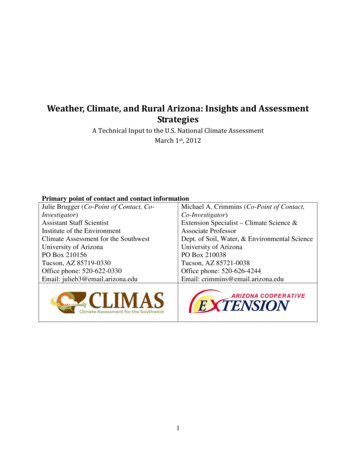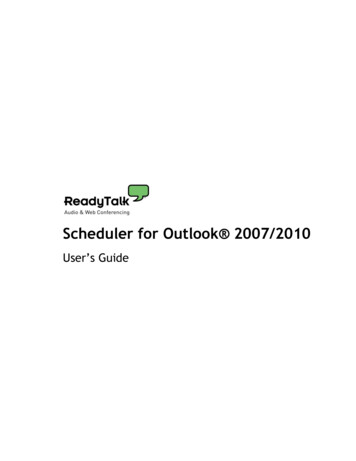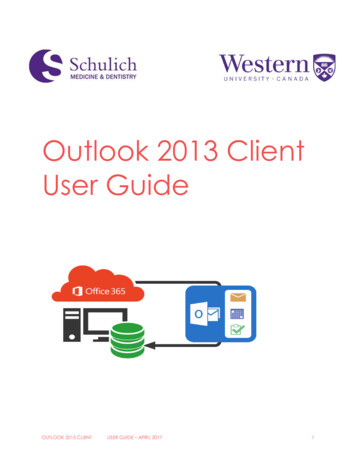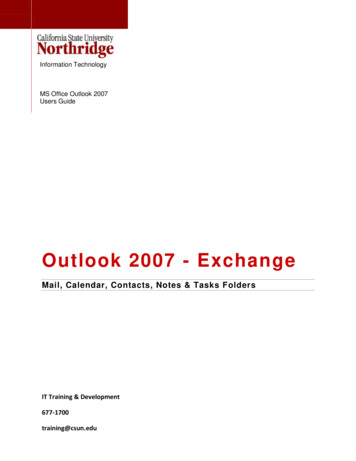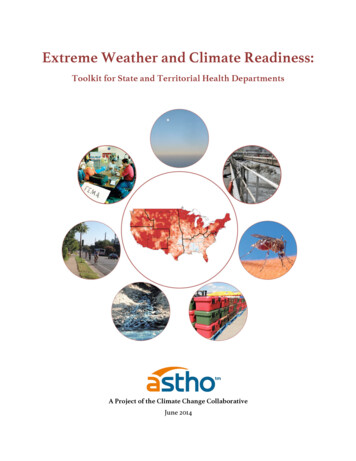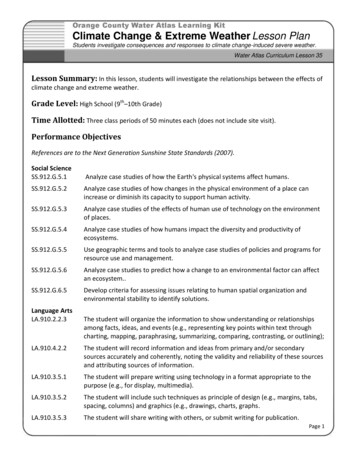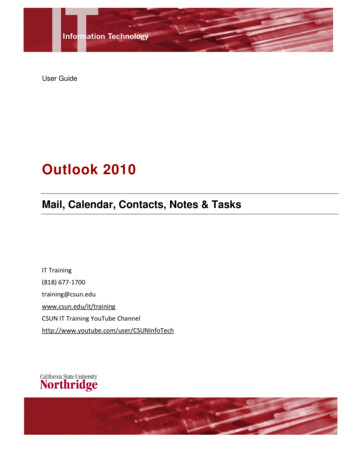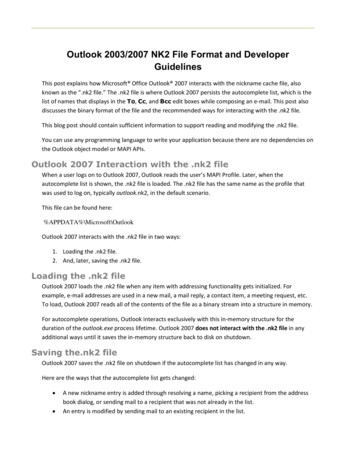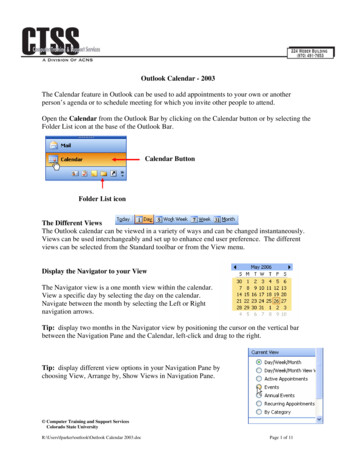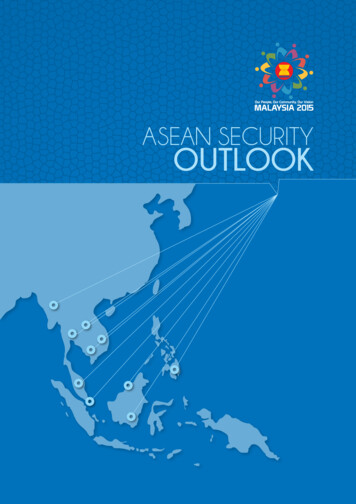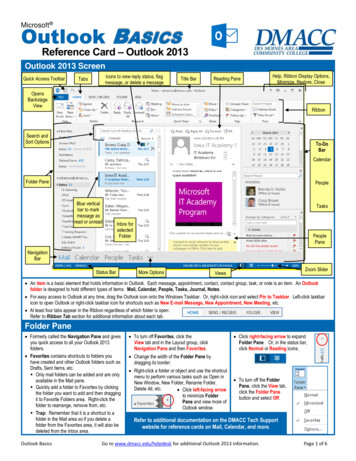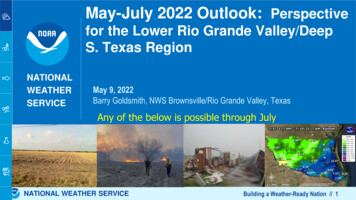
Transcription
May-July 2022 Outlook: Perspectivefor the Lower Rio Grande Valley/DeepS. Texas RegionNATIONALWEATHERSERVICEMay 9, 2022Barry Goldsmith, NWS Brownsville/Rio Grande Valley, TexasAny of the below is possible through JulyNATIONAL WEATHER SERVICEBuilding a Weather-Ready Nation // 1
Spring So Far March and most of April showed steadyworsening of the drought, with Level 3(Extreme) and Level 4 (Exceptional) reachingthe Rio Grande Plains/Brush Country, asexpectedWildfire “season” was active, with anestimated 33,000 acres burned in rural DeepS. Texas ranch/brush country and the upperValley between February and early AprilA “one-off” torrential rain event on April 25/26temporarily improved dryness/drought andhumidity that followed quelled the wildfireseason into early MayNATIONAL WEATHER SERVICE“Hayfield” Fire on the Norias Divisionof the King Ranch, March 24/25, 2022Building a Weather-Ready Nation // 4
Seasonal Forecast May-July 2022 - USARGVNATIONAL WEATHER SERVICERGVBuilding a Weather-Ready Nation // 5
Key Takeaways Above to average temperatures, and a “lean” toward below average rainfall continues.Confidence is high on a hot and largely rain-free May, then mixed on if the pattern changes in Juneand July Drought will worsen once again across the Rio Grande Plains/Brush Country in May, andultimately spread to parts of the Rio Grande Valley. Extreme to Exceptional (highest on scale)Drought is likely across Rio Grande Plains and Brush Country, with Moderate Droughtspreading to all but the Lower Texas coast. Excessive Heat had already impacted some locations across the Brush Country/Rio GrandePlains in early May, and this may be a big story through July in most areas. A hot and largelyrain-free pattern would produce several days of apparent temperatures between 111ºF and 120ºF– locally higher. Wildfire spread threat could re-appear in Brooks/Hidalgo through Zapata by late May andpotentially continue on and off through July - based on fuel (grass, brush, tree) availability,dryness, and the expected warmth and drought. June and July are still “wild cards”, though June is leaning dry. Based on historical precedent insprings like this, a reasonable chance for excessive lightning, and flooding should thunderstormclusters, or unnamed tropical waves develop or spread into the region. June 2018 and 2019 standout.NATIONAL WEATHER SERVICEBuilding a Weather-Ready Nation // 6
The “Why” of the Forecast:El Niño/Southern Oscillation (ENSO) (still) in La Niña Phase La Niña remains stubborn,and is now expected to remainthe dominant signal intosummer, with only slowweakeningThe staunch latespring/summer La Niñacombined with generalatmospheric patterns andother “teleconnections”generally favors hot anddry/drought conditions intoJuly*Above right: Oceanic Niño Index.Values below -0.5 (light blue) indicate a3-month La Niña episode.NATIONAL WEATHER SERVICEBuilding a Weather-Ready Nation // 7
The “Why” of the Forecast: Pacific DecadalOscillation (PDO) in Negative Phase The 2021/2022 prolonged negative PDO is now similar to that of late 2010 through 2011. Combined wththe persistent La Niña – also very similar to that from late 2010-2011 (though 2011 was a bit stronger),confidence is building on a prolonged warm to hot and dry late spring into early-mid summer 2022.June into early July could still be a wild card as the month in recent years has featured notablethunderstorm and flood impacts.NATIONAL WEATHER SERVICEBuilding a Weather-Ready Nation // 8
The May-July 2022 Outlook: Rio Grande Valley(McAllen as Anchor Point) Temperature: A 39 percent chance of above average. RGV averages (daytime): Rising from the lower 90s (earlyMay) to 100 (end of July)Precipitation: Equal chances ( 33.3 percent of all three categories), RGV averages: 6 to 7 inches.Of note: Average temperatures rose 2 degrees for the 1991-2020 sample, making it more difficult to forecast asummer value much above this.NATIONAL WEATHER SERVICEBuilding a Weather-Ready Nation // 9
The May-July “Droughtlook”April 19, 2022 Drought is likely to return toward Extreme to Exceptional across the BrushCountry/Rio Grande Plains into early June, with Moderate to Severe conditionslikely spreading back into the populated Rio Grande ValleyMay 3,Rains in June and July are a “wild card”. If rains come as they did in June/July2018-2021, drought will be removed. If they don’t come, Severe to Exceptionalconditions will dominate all of the Valley/Brush Country by July.NATIONAL WEATHER SERVICEApril 20, 20212022Building a Weather-Ready Nation // 10
Falcon Reservoir Only a Tad Above 30-yearLows, at start of May 2022 Early May 2022 total capacity, Falcon Reservoir: 17 percentEarly May 2011 total capacity, Falcon Reservoir: 70 percentNATIONAL WEATHER SERVICEBuilding a Weather-Ready Nation // 11
May 2022: Confidence High on Dry and Hot RGVRGVRGVRGVNATIONAL WEATHER SERVICE Bottom Line: May will continuehot, humid, breezy, with little rain– threatening top-ten warmest alltime. Drought re-intensifiesand spreads back east, withsome potential for wildfirespread on some daysTransitional green-up aided bythe fairly widespread heavyrainfall on April 25/26 will beginfading in mid to late May; if Juneremains dry, peak evaporationrates will turn grass and brushinto fuel ready to burn, especiallyin lower humidity areas mainlyfrom Brooks/western Hidalgothrough Zapata County.Building a Weather-Ready Nation // 13
Late Summer/Early Autumn 2022: Continued Heat; RainfallUncertain (tropical systems always a wild card)RGVRGVNATIONAL WEATHER SERVICERGVRGVRGVRGVBuilding a Weather-Ready Nation // 14
Bottom Lines Heat should be dominant through July, perhaps setting the stage for another top-ten warmest yearshould much warmer than average conditions prevail through the rest of 2022. Heat safety should bepromoted frequently.Drought is likely to reset to extreme to exceptional (the highest on the 5-level scale) mainly westof IH 69/US 281 by early to mid June. Re-development of moderate to perhaps severe (levels 2 and 3on the scale) is possible into key growing areas of Hidalgo County. “Transitional” green will turn back toyellow/brown across the lower Valley through Kenedy and Brooks by late May/early June.Agriculture and municipal water shortages are likely to increase with high evaporation, lack ofsignificant rainfall, and very low water levels in Falcon Reservoir, through at least early June. Late Juneand July are wild cards, but the “lean” this year is drier vs. wetter based on a persistent pattern, alreadyshowing signs of “La Canícula” in May. Conservation, smart irrigation, rainwater harvesting, etc. arediscussion topics.Mid June through July are now the “wild card” months. Continuation of hot and rain-free weatherdeep into summer will spread extreme drought into the agriculturally-rich easternHidalgo/Willacy/western Cameron region, with an increasing potential for rapid to extreme wildfiregrowth on breezy, very hot, and relatively “dry” days.However, a wetter (and less hot) month would reduce the drought and be a “just in time” boon toagriculture, though significant flash flooding could occur due to intense thunderstorms, as seen in 20182019, and in early July 2021.NATIONAL WEATHER SERVICEBuilding a Weather-Ready Nation // 15
for the Lower Rio Grande Valley/Deep S. Texas Region May 9, 2022 Barry Goldsmith, NWS Brownsville/Rio Grande Valley, Texas . likely spreading back into the populated Rio Grande Valley Rains in June and July are a "wild card". If rains come as they did in June/July 2018-2021, drought will be removed. If they don't come, Severe to .
